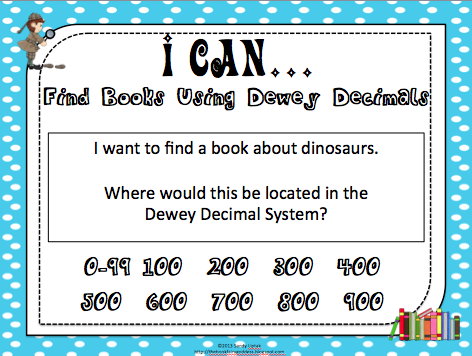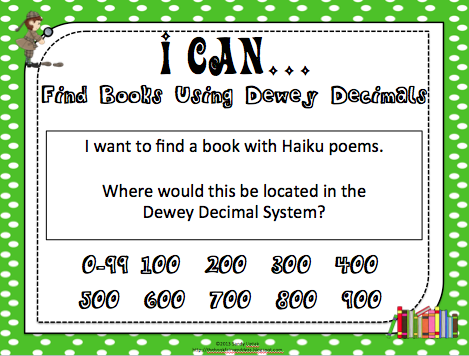Our district has spent a lot of training and inservice on different ways to assess student learning. The areas that we focused on the most were Assessment FOR learning and Assessment OF Learning. I felt comfortable doing this in the classroom, but it became challenging for me to find ways to assess students’ learning when it came to the library, as our time is so short.
Out of the two different ways to assess, Assessment FOR learning was definitely easier to do, as it is a natural way of teaching for me. I used a pocket chart to state the week’s objectives for each grade level on laminated sentence strips. Each week, I wrote “I Can” statements and we discussed the target learning before the lesson.
This allowed me to gauge where they were on this learning target, and gave the students some direction as to what they would be responsible for understanding. Throughout the lesson, I would question the students, provide feedback, and adjust my teaching as necessary.
Assessment OF Learning proved to be more difficult for me to wrap my head around in regards to the library. My lessons generally ran 15-20 minutes, and students had 5-10 minutes to check out and go to centers before they left the library. There just didn’t seem to be enough time to fit it all in. As a result, I made it a goal last year to be creative and find ways to do some Assessments OF Learning with the students. I decided to try it out with 2nd-5th grade on two different units: Destiny Searches and the Dewey Decimal System.
Destiny Searches
Learning how to search for books is an important skill that I really focus on with my 2nd-5th graders. I noticed that most of them typed in a topic in the search box and then hit return which defaulted to a “keyword” search. Unfortunately this didn’t always get them the type of books that they were looking for, or it gave them way too many search results.
In the past I would spend the first week showing them the different search options (author, title, subject, series, keyword). Then, in the next week, I would have them practice doing different types of searches.
Last year, I decided to add in an assessment component. I created task cards with different types of search questions that covered the options that we had covered (author, title, subject, and series).
I printed them off 4 to a page so that they were smaller, and then hole-punched them in the corner and put them on a ring. As students came up to check out their books, I would flip through the questions. If they answered it correctly, they could check out their book. If they didn’t answer correctly, I would use that as an opportunity to reteach and have them go to the end of the line to try again. I even linked some Jing videos on our webpage on how to search on Destiny so that they could review if necessary.
This year, I want to add one additional assessment piece, something that the students can actually put in their portfolio binder to show the skills that they were mastering in the library. So, I created a short 10-question quiz over the different types of Destiny searches.
Dewey Decimal System
I really like these quick Assessments OF Learning task cards. I can use them for assessment purposes, but can also put them in my Game Center. I’m working on creating more task cards right now on Fiction Genres, Poetry types and terms, and will even do one on the parts of a book and book care for my younger students. If you would like any of these items, please visit my TpT store.
I’m curious, though, if any one else has come up with other ways to assess students in the library? I’d love to hear your ideas!
Sandy
























Will you talk about these portfolio binders you mentioned? Are they specific to the library?
No Wendy, they're not specific to the library. Our district encourages all Elementary teachers to create Portfolios and/or Data binders with their students. It contains information on their growth throughout the year. Some teachers call it their "I can" binder, which showcases the skills that the students have mastered. Others use it to show skills that were worked on each 9 weeks. I'm trying to get library skills incorporated into those binders, at least with a few samples of work that we are doing in the library each 9 weeks for each grade level. That's my goal, anyway. 🙂
My school district is implementing Assessment for Learning, but we branded it Assessment Literacy. It is being fully implemented this year and all staff will receive training. I am one of the building team leaders at my school this year, but feel like learning is ever evolving.
Like you, I post my students "I can…" learning targets in pocket charts. At my school last year, the special area teachers had to incorporate writing and portfolio tracking with students, so my students ended being assessed more on written assignments. I did create a rubric for my students. Since I don't give actual grades, the rubric was broad and consisted of a check, check minus, and minus. I checked for name on paper, work completion, and correct work. It worked rather well.
Amanda
http://thatswhatiwantmychildtoread.blogspot.com/
Thanks Amanda! I wanted to create a matrix of library skills per grade level this summer, but time just got away from me. I purchased binders for each grade level, and was going to have a divider for each teacher. I thought that I could have a copy of the matrix for each student hole punched, and whenever we went over a specific skill or assessed on a skill, then I got have them get their paper and check it off or write in the date. The logistics just seem a little time consuming, so I'm still trying to work that part out (and figure out the matrix as well). It'll be my work in progress this year!
I downloaded your destiny search card activity but can’t find the 10 question assessment. Where can I find it?
Hi Leslie,
The 10 question quiz can be found here at https://www.teacherspayteachers.com/Product/Destiny-Search-Quiz-811215.
🙂 Sandy
What you have on this page as being free on TPT is no longer there. I paid .50 cents for what I thought was the quiz but it is an incomplete version. Please post the link to the quiz you posted here or take down the offer to get it for free on TPT, it is misleading.